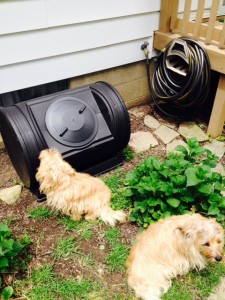Composting is Cool
Composting is actually not cool. It is warm when done right, but you get what I mean.
Did you know that two-thirds of everything we throw away is compostable? That’s what Don Blakesley, Erie County Recycling Coordinator, says. In Erie County (Pennsylvania) today, on average, each person generates 3,400 lbs. of trash per year. Want to know how much ends up in the growing mountain called Lakeview Landfill? Would you believe almost 80%?
I learned all this last weekend, when I attended a valuable workshop called Compost: The New “Black Gold” at the Tom Ridge Environmental Center. The workshop was sponsored by environmentERIE , Erie County Recycling Program , and Millcreek Township. It was valuable because of knowledge I gained, but also because each attendee received a free Compost Wizard Jr., a $159 value!
We used to have a compost bin at our old house, made of scraps from our deck construction, but we really only used it for the overwhelming amount of leaves our oak trees dropped every fall. When I would think about it, I would run watermelon rinds or cornhusks out there, but in the winter, not so much. Now that I have this nice composter sitting in the dogs’ run right outside the back door, I think I’ll be composting kitchen scraps all of the time. As for the leaves, we have plenty at the new house, too, but the quantity is too large for a composting bin. They are better off just corralled in a designated area under the row of hemlocks that line the rear boundary of our yard.
Composting always seemed a bit overwhelming in the past, but after Saturday’s workshop, I understand the process much better. All one needs to know is what can be composted and what cannot, in addition to remembering the 2:1 brown:green ratio. What I really found interesting is that newspapers and shredded paper count as browns. The leaves in the backyard would count as browns, too.
What can’t be composted? Food containing animal products, household animal waste, and walnut-tree remnants. If you spread compost containing walnut-tree remnants around your plants, they won’t grow. You should also be careful about composting seeds, because you could have cucumbers growing in your flowerbed. I don’t see that as a bad thing, though.
Once a bin is filled, making a batch, it will take about two months to make compost in spring, summer, and fall. In the winter, not much happens inside a compost bin. When the compost is ready, it needs to cure. So you would just empty the contents of the bin onto a pile and let it sit for a week. Then you can use it on spots in your yard that don’t seem to be able to grow grass, in your garden, or around your trees. If you use it around trees, keep the compost three inches from the tree and at a three-inch depth.
The composting classes are offered four times per year, and unfortunately, the classes are sold out for this year. But that doesn’t mean you can’t start composting. There are many Web sites that will give you good tips on how to get started.

At the workshop, we also heard from Judy Zelina about municipal composting at the Millfair Compost & Recycling Center, and Matt Pluta from environmentERIE told us about RecyclErie, which helps small businesses in the area save trash-hauling costs by recycling. I will write about those topics in future posts.
When I got home from the workshop with my new composting bin, I set it up and immediately started composting with some celery scraps that I’d been saving.
What a relief. No more guilty feelings while running scraps down the garbage disposal. And perhaps the compost we produce here will be the cure to my brown thumb . . . . Probably not. Composting might be cool, but it’s not magic.
Ann Silverthorn (Twitter: @annsilverthorn) is a versatile blogger who also writes about a wide variety of topics in numerous genres, including non-fiction, fiction, poetry, travel, and grant writing.
More posts from the composting workshop:
Save Time & Money on Twigs & Trash
RecyclErie – Too Good to Pass Up




Leave a Reply